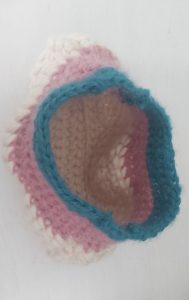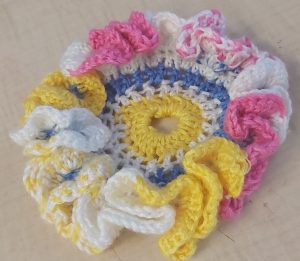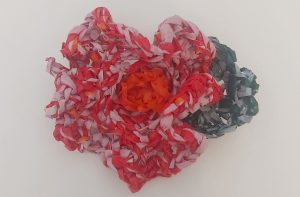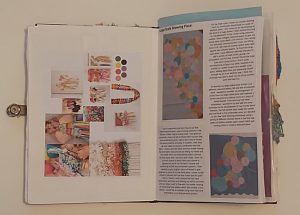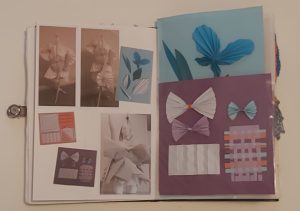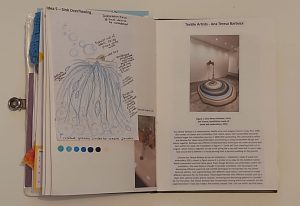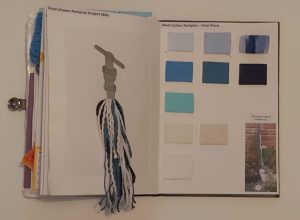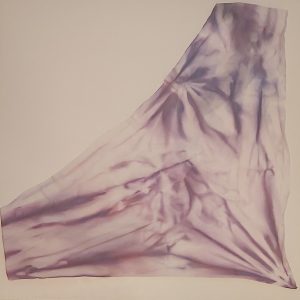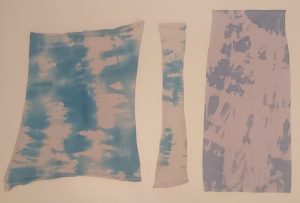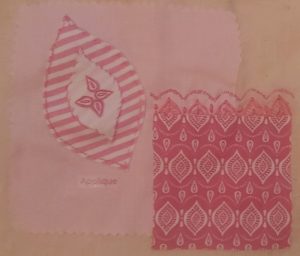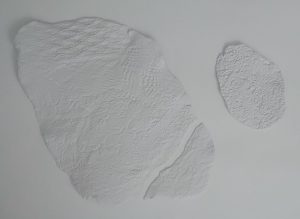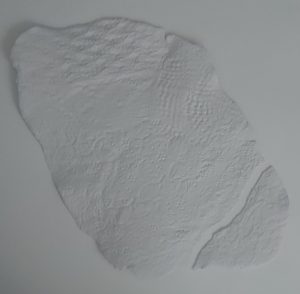Base of Final Piece:
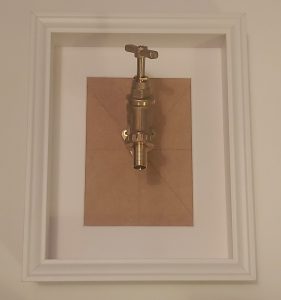



Start of Crocheted Water:






Final Personal Project Complete with Daisy’s:


For my final personal project, I considered various ideas. I wanted to create something that was tactile, tangible and textured. I had considered creating a tapestry, with sensory elements by incorporating all the techniques I have learned through my time in fashion and textiles however, I felt this would be hard to achieve in a short period of time. For the large-scale drawing experiment, I enjoyed freely drawing circles of different sizes and colours, from this I thought about incorporating circular and spherical shapes into my final project by allowing circular elements to cascade from a metal ring suspended from the ceiling, I began to focus on crocheted circles, accidentally discovering a way to create flowers by increasing my stitches each time. The word cascade brought to mind the idea of water cascading down a waterfall, which led to the idea for my final personal project piece. In considering my final personal project, I thought of the elements of the module that I have enjoyed most. I have particularly enjoyed crochet and teaching myself new techniques and stitches. I like how the pieces suddenly build to produce delicate pieces. I have learned how to use various materials to crochet, using various types of wool, strips of plastic shopping bags and using my arms to crochet, creating a large chunky wool granny circle. I have enjoyed building my knowledge through research of textile designers, sustainable fashion and about the impacts of fast fashion on our environment and society. I have found it intriguing to discover artists and designers who have a genuine commitment to creating a better future for our planet, not only by choosing sustainable materials through recycling, upcycling and reducing waste but also by using their art and designs as a platform to build awareness to the impacts of fast fashion – excessive consumption and waste. I was intrigued to learn how much water is used to make one pair of jeans, one t-shirt and one pair of socks. I discovered that the water used to create a simple day-to-day outfit was 13300 litres, I compared this to giving a 500ml bottle of water to nearly every student across all four campuses of Ulster University. I feel the idea of water consumption for fashion works well with my final project piece. I considered how I could produce a piece that would allow my crochet to cascade like water, initially thinking I could create a papier mâché sink with tap, overflowing with water made from strips of recycled fabrics. I considered creating a vase which had fallen over with water and flowers spilling from it. I decided to use a tap on its own, fixing it to a frame, with the focus the water overflowing or freely flowing from a tap to represent our wasteful habits regarding water. The water crisis is a global concern, exacerbated by excessive use in agriculture and manufacturing, I want to use my final personal piece as a way to highlight the excessive water usage, to draw awareness to how we as individuals should be mindful of our own consumption, by collectively reducing our consumption and appreciating every droplet and how privileged we are in our country to have fresh, clean, flowing water we can start to improve on the impact that the global water crisis is having on our planet. Ikea have joined the fight to combat excessive use of water by suggesting some tips, their article highlights the quantities of water that could be saved by making small changes. By switching the tap off while brushing our teeth, we can save just under 50 litres of water per day per person. It is said that running a regular tap for only sixty seconds allows up to 12 litres of water to go down the drain. (IKEA) It is recommended that we brush our teeth for two minutes twice a day that would be 48 litres of water wasted. We need to be conscious of our actions and mindful of how precious water is to human and plant life, it is a finite resource that must be cherished and saved at all costs. I decided to add a few crocheted daisies and roses to my final piece to represent nature and the plant life that also relies on water for survival. I took first hand images of water flowing from an outdoor tap to study how the water cascades, pours, and flows from the tap. To create my final personal piece, I created lengths of swirling crochet in different hues of blue to give depth. I created thick and thin strands using chain stitch. I fixed a brass tap to a piece of MDF and bought a deep frame to display it. I had to be conscious of the weight of the tap within the frame so that it would be easy to secure. I got a sample piece of wallpaper from a hardware store in a realistic brick style, to place behind the tap for a more authentic look. I initially used bright turquoise coloured wool, adding an aqua coloured raffia and hand knitted strips, however I felt that these did not compliment the piece therefore choosing to remove them. I wanted to create a look that plays on the word flow and cascade, I feel that I have achieved this with this piece. I found it challenging to decide on the length that each strand should be without it being on the wall where I want to place it, I had to decide if the water should puddle onto a surface or flow in a steady stream to the ground. I felt that a steady flow cascading from the tap to reach the ground was enough. I chose to display my piece on a shelf which allows the water to flow out and over the edge. Once the piece was on the shelf against the white wall, I was able to see that the overall piece needed more blue crocheted strands for balance. I wanted to bulk out the ends and give a feeling that the water was splashing up from the ground therefore, I decided to add a few extra crocheted strands and frills using cream and white wool. I incorporated some crocheted daisies to reflect nature and growth and the need for water within our eco system to feed plant life. Overall, I am pleased with my final piece, I love how the word cascade broadened my thinking which led to acknowledging the current global water crisis and to really consider how water is excessively used. I enjoyed trying to create the sense of flow in this piece. On reflection, if I had more time, I would have liked to learn more crochet techniques and stitches to create different textures however, I feel what I have produced has been successful.
IKEA, 2019. Available on: 17 ways to reduce water consumption (ikea.com) [Accessed on: 9th May 2023]








